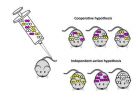(Press-News.org) An international team of academics, including Professor Marco Oggioni from the University of Leicester's Department of Genetics, has studied how localised infections can turn into the dangerous systematic disease sepsis – and has identified for the first time through genetic evidence that a single bacteria could be the cause.
The study, which has been published in the academic journal PLOS Pathogens, examined the events that lead to sepsis by Streptococcus pneumoniae (pneumococcus), a major human pathogen, in mice. They found that in most cases the bacteria causing sepsis was started by a single pneumococcal cell.
The study was an interdisciplinary collaboration between the Departments of Genetics, Infection Immunity and Inflammation and Mathematics at the University of Leicester, Professor Richard Moxon at the University of Oxford and scientists from overseas including the University of Siena.
Professor Oggioni said: "Our data in experimental infection models indicate that we do not need only strategies which target many bacteria when it is too late, but that early intervention schemes which prevent the one-single cell that starts the disease process might provide substantial benefit to the patient.
"In this work we have for the first time provided genetic evidence for a single cell origin of bacterial invasive infection. The scenario was hypothesised over 50 years ago, but so far only phenotypic and statistical evidence could be obtained for this event."
Under normal circumstances, when different bacteria are used in models of experimental infection of hosts who have not previously encountered the same pathogen, the vast majority is destroyed rapidly by the host's innate immune system.
In the researcher's model, a dose of one million bacteria is needed to induce systemic disease in about half of the hosts in the study.
This is in stark contrast to a much lower number of bacteria thought to make up the starting "seed" that leads to the development of systemic infection - and the assumption is that there must be one or more "bottlenecks" in the development of the disease.
To investigate these bottlenecks, the researchers injected mice with a mix of three different variants of S. pneumoniae. About half of the mice developed sepsis and in almost all cases the bacteria causing sepsis were derived from only one of the three variants used in the initial challenge.
Using statistical analysis as well as direct DNA sequencing, the researchers could show that in most cases the bacterial population causing sepsis was started by a single pneumococcal cell.
When the researchers looked closer at how the immune system resists most injected bacteria, they found that macrophages, a type of immune cell that can gobble up bacteria, and specifically macrophages in the spleen, are the main contributors to an efficient immune response to this pathogen.
Their findings suggest that if bacteria survive this initial counter-attack, a single 'founder' bacterium multiplies and re-enters the bloodstream, where its descendants come under strong selective pressure that dynamically shapes the subsequent bacterial population – resulting in the sepsis.
The data also suggests that the single bacterium leading to sepsis has no obvious characteristics that give it an advantage over the 999,999 others, but that random events determine which of the injected bacteria survives and multiplies to cause disease.
It is believed that the findings, suggesting that the development of sepsis starting from a single founding cell which survives the immune system's initial counter-attack in mice, could also potentially apply to human systemic infections.
This information could prove vital to understanding sepsis, as the causes of the disease are still largely unknown to the scientific community.
Dr Oggioni added: "Knowing that there is a moment when a single bacterial cell escapes "normal" immune surveillance at the beginning of each invasive infection is an important paradigm and essential information which, in our opinion, should lead to changes in therapeutic protocols in order to maximise success of treatment outcome."
INFORMATION:
The study, 'The Role of Host and Microbial Factors in the Pathogenesis of Pneumococcal Bacteraemia Arising from a Single Bacterial Cell Bottleneck', has been published in the academic journal PLOS Pathogens on Thursday 20 March.
Genetic evidence for single bacteria cause of sepsis identified for the first time
University of Leicester academic involved in study into single bacteria causes of systematic disease
2014-03-21
ELSE PRESS RELEASES FROM THIS DATE:
Lightweight construction materials of highest stability thanks to their microarchitecture
2014-03-21
This news release is available in German. KIT researchers have developed microstructured lightweight construction materials of highest stability. Although their density is below that of water, their stability relative to their weight exceeds that of massive materials, such as high-performance steel or aluminum. The lightweight construction materials are inspired by the framework structure of bones and the shell structure of the bees' honeycombs. The results are now presented in the journal PNAS, DOI: 10.1073/pnas.1315147111.
"The novel lightweight construction materials ...
New method can diagnose a feared form of cancer
2014-03-21
The poor prognosis for pancreatic cancer, where only 5 percent of the patients survive five years after the diagnosis, is due to the fact that the tumors often develop unnoticed, and rarely cause symptoms until they have spread to other organs. Recent studies, however, have shown that fluid-filled compartments in the pancreas, called cysts, may be precursors of the cancer.
Cysts in the pancreas, which are found in every 10th person above the age of 70, and are also common in younger people, can be discovered with computed tomography (CT) or magnetic resonance imaging ...
Genetic factor contributes to forgetfulness
2014-03-21
Misplaced your keys? Can't remember someone's name? Didn't notice the stop sign? Those who frequently experience such cognitive lapses now have an explanation. Psychologists from the University of Bonn have found a connection between such everyday lapses and the DRD2 gene. Those who have a certain variant of this gene are more easily distracted and experience a significantly higher incidence of lapses due to a lack of attention. The scientific team will probably report their results in the May issue of "Neuroscience Letters," which is already available online in advance.
Most ...
Salivary biomarkers of gingivitis: Information important for personalized decision-making
2014-03-21
Alexandria, Va., USA – Today during the 43rd Annual Meeting & Exhibition of the American Association for Dental Research, held in conjunction with the 38th Annual Meeting of the Canadian Association for Dental Research, Craig Miller, University of Kentucky, Lexington, will present research titled "Salivary Biomarkers of Gingivitis: Information Important for Personalized Decision-Making."
Salivary biomarkers have been studied to help determine the presence, risk, and progression of periodontal disease. However, clinical translation of salivary biomarkers from bench to ...
Novel pro-resolving-medicines in periodontal regeneration
2014-03-21
Alexandria, Va., USA – Today during the 43rd Annual Meeting & Exhibition of the American Association for Dental Research, held in conjunction with the 38th Annual Meeting of the Canadian Association for Dental Research, Daniel Huy Nguyen, The Forsyth Institute, Cambridge, Mass., will present research titled "Novel Pro-Resolving-Medicines in Periodontal Regeneration."
Uncontrolled host defense mechanisms can significantly impede tissue engineering, regeneration and reconstruction of oral and craniofacial tissues. The anti-inflammatory and pro-resolving actions of lipoxins ...
Water fluoridation: Safety efficacy and value in oral health care
2014-03-21
Alexandria, Va., USA – Today during the 43rd Annual Meeting & Exhibition of the American Association for Dental Research, held in conjunction with the 38th Annual Meeting of the Canadian Association for Dental Research, a symposium titled "Water Fluoridation: Safety Efficacy and Value in Oral Health Care" will take place. This symposium will be chaired by Stephen H. Abrams, Cliffcrest Dental Office, Toronto, Ontario, Canada.
Community water fluoridation (CWF) and other fluoride modalities historically have been and remains the cornerstone for the prevention and control ...
9/11 linked to two heart disease culprits: Obstructive sleep apnea and PTSD
2014-03-21
Icahn School of Medicine at Mount Sinai researchers have linked high levels of exposure to inhaled particulate matter by first responders at Ground Zero to the risk of obstructed sleep apnea and post-traumatic stress disorder (PTSD), both conditions that may impact cardiovascular health.
The two separate studies were both presented on March 20 at the American Heart Association's EPI/NPAM 2014 Scientific Sessions in San Francisco, California by cardiologist Mary Ann McLaughlin, MD, MPH, principal investigator for the WTC-CHEST Program at Mount Sinai, a subset of the World ...
Food insecurity linked to cost-related medication underuse in chronically ill Americans
2014-03-21
Philadelphia, PA, March 21, 2014 – Chronically ill adults who reported food insecurity in their household (not having consistent access to food due to lack of financial stability) were significantly more likely to report cost-related medication underuse, according to a new study in The American Journal of Medicine,. The term cost-related medication underuse refers to taking less medication than prescribed, or not taking it at all due to financial concerns.
Despite renewed optimism about the economy, many people in the United States continue to feel financial hardships. ...
P&G Beauty to present advancements in skin care technologies at annual AAD Meeting
2014-03-21
Denver, CO (March 21, 2014) – Research presented by P&G Beauty scientists at the 72nd Annual Meeting of the American Academy of Dermatology (AAD) offers insights into new ingredient formulations and effective skin care routines. P&G Beauty will showcase several studies that address a range of topics including cellular bioenergetics, anti-aging technologies, microdermabrasion systems and sensitive skin body wash efficacy.
"P&G Beauty is proud to share our research at this year's AAD meeting, and is looking forward to collaborating with experts in the field of dermatology," ...
Preterm children at increased risk of having maths problems
2014-03-21
Researchers have found that preterm children are at an increased risk of having general cognitive and mathematic problems.
The new study by the University of Warwick and Ruhr-University Bochum, published in the Journal of Pediatrics, sought to understand the relationship between preterm birth and dyscalculia.
Dyscalculia, a learning disorder which involves frequent problems with everyday arithmetic tasks, is diagnosed when children do worse in maths than would be expected based on their general intelligence.
Study co-author Professor Dieter Wolke from the University ...
LAST 30 PRESS RELEASES:
Numbers in our sights affect how we perceive space
SIMJ announces global collaborative book project in commemoration of its 75th anniversary
Air pollution exposure and birth weight
Obstructive sleep apnea risk and mental health conditions among older adults
How talking slows eye movements behind the wheel
The Ceramic Society of Japan’s Oxoate Ceramics Research Association launches new international book project
Heart-brain connection: international study reveals the role of the vagus nerve in keeping the heart young
Researchers identify Rb1 as a predictive biomarker for a new therapeutic strategy in some breast cancers
Survey reveals ethical gaps slowing AI adoption in pediatric surgery
Stimulant ADHD medications work differently than thought
AI overestimates how smart people are, according to HSE economists
HSE researchers create genome-wide map of quadruplexes
Scientists boost cell "powerhouses" to burn more calories
Automatic label checking: The missing step in making reliable medical AI
Low daily alcohol intake linked to 50% heightened mouth cancer risk in India
American Meteorological Society announces Rick Spinrad as 2026 President-Elect
Biomass-based carbon capture spotlighted in newly released global climate webinar recording
Illuminating invisible nano pollutants: advanced bioimaging tracks the full journey of emerging nanoscale contaminants in living systems
How does age affect recovery from spinal cord injury?
Novel AI tool offers prognosis for patients with head and neck cancer
Fathers’ microplastic exposure tied to their children’s metabolic problems
Research validates laboratory model for studying high-grade serous ovarian cancer
SIR 2026 delivers transformative breakthroughs in minimally invasive medicine to improve patient care
Stem Cell Reports most downloaded papers of 2025 highlight the breadth and impact of stem cell research
Oxford-led study estimates NHS spends around 3% of its primary and secondary care budget on the health impacts of heat and cold in England
A researcher’s long quest leads to a smart composite breakthrough
Urban wild bees act as “microbial sensors” of city health.
New study finds where you live affects recovery after a hip fracture
Forecasting the impact of fully automated vehicle adoption on US road traffic injuries
Alcohol-related hospitalizations from 2016 to 2022
[Press-News.org] Genetic evidence for single bacteria cause of sepsis identified for the first timeUniversity of Leicester academic involved in study into single bacteria causes of systematic disease



